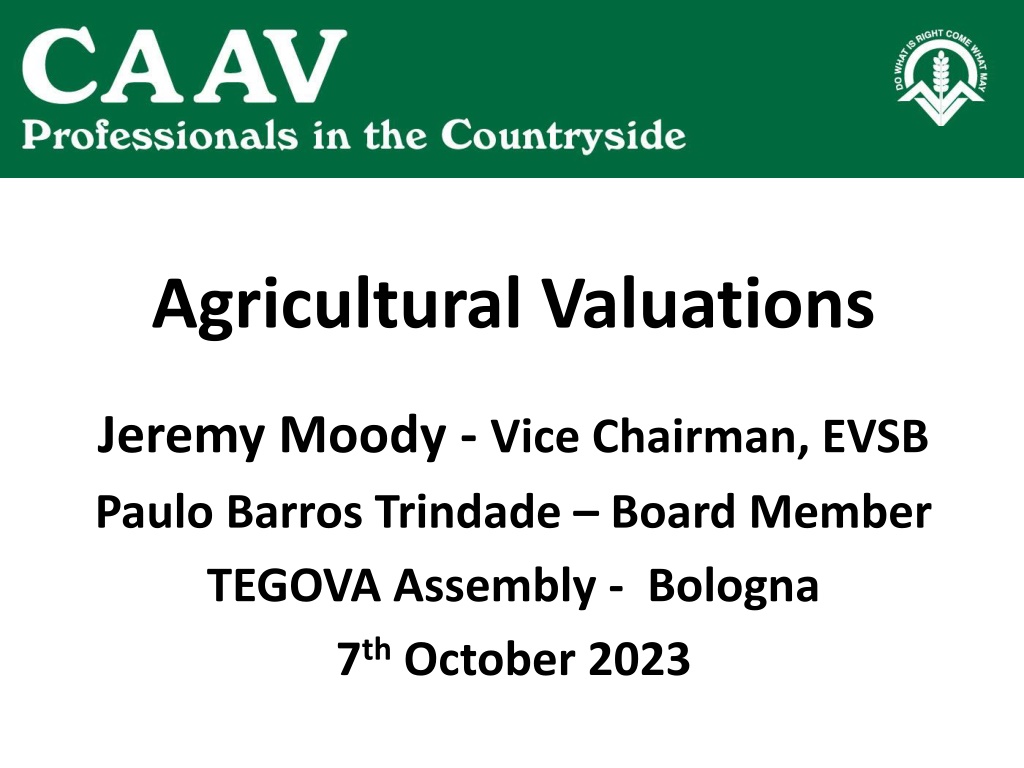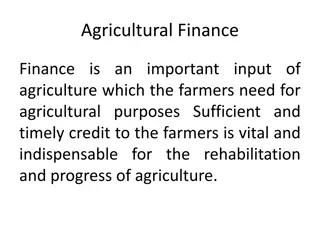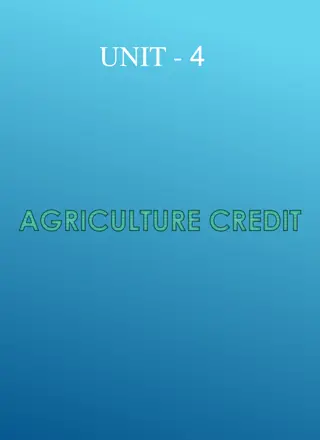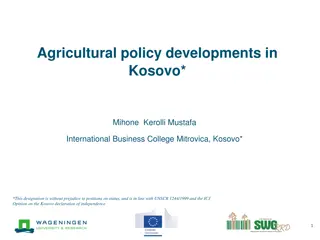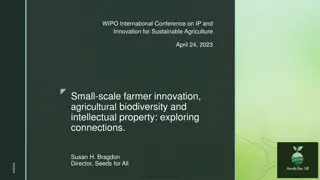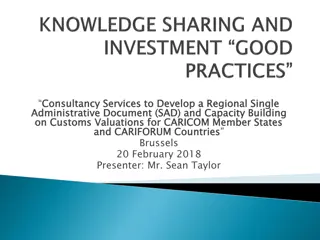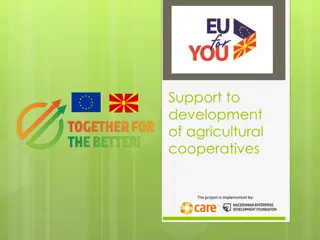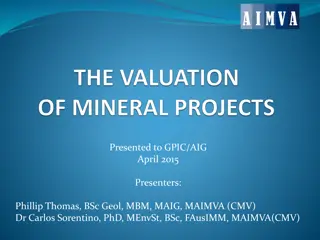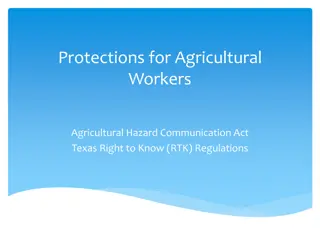Challenges and Trends in Agricultural Valuations and Regulations
Exploring the complexities of agricultural valuations and regulations in European countries, this content delves into the diversity of agriculture across different regions. It discusses the challenges faced in understanding farmland markets, the impact of new factors like climate change, and the importance of regulations governing land use and taxation. With a focus on the evolving agricultural landscape, the content emphasizes the need for guidance and collaboration in navigating the intricacies of agricultural practices and policies.
Download Presentation

Please find below an Image/Link to download the presentation.
The content on the website is provided AS IS for your information and personal use only. It may not be sold, licensed, or shared on other websites without obtaining consent from the author. Download presentation by click this link. If you encounter any issues during the download, it is possible that the publisher has removed the file from their server.
E N D
Presentation Transcript
Agricultural Valuations Jeremy Moody - Vice Chairman, EVSB Paulo Barros Trindade Board Member TEGOVA Assembly - Bologna 7thOctober 2023
EVS Agriculture Paper Long been a Board ambition Aim is for a Guidance Note in EVS 2025 Text now developing Questionnaires to Member Associations EVSB reviewed a working draft text yesterday The challenge is the variety of situations, markets and approaches between countries ASAVAL/CAAV Conference Lisbon March 15th Final text for Bucharest Assembly
Diversity of Agriculture All European countries have agricultural land But it is very varied Different geographies From vineyards to mountain pasture Different national histories and legislation Different agricultural policies, even in EU CAP Different and local cultures and customs Interacting with differing other uses Housing, environmental, forestry, sporting, amenity Now also renewable energy
Understanding Difference Are farmland markets active or not? Are they transparent or not as to prices? Extent of national legislative intervention Ownership, transactions and tenancy law Does food production depend on using land or on investment in facilities? Cropping/grazing or covered/indoor production Does value lie only in food production potential or a wider range of market factors? Histories of land reform and collectivisation
New Factors Unfolding climate change: Impact, mitigation and adaptation Environmental concerns and expectations Growing constraint of and competition for access to water and how to manage it best Assured supply can support high value production Global supply chains disruption and markets Inputs, produce markets, consumer taste Impact of climate change elsewhere New technologies automation, genetics, data
Regulation Regulation of land use Taxation of property Agricultural policies EU s CAP and others Norway and Switzerland to Ukraine Environmental issues schemes and rules Resource protection impact on rural land water, soil, biodiversity, etc Health and Safety, labour, planning, Complex but can protect or offer value
Why Value Farmland? For sale or purchase For letting and tenancy issues For security for lending/borrowing For accounts and business decisions For private contracts and disputes For tax on death, on sale land taxes, etc For compulsory purchase by the state Business creation, business break up, divorce Many other reasons
What Is To Be Valued? Property and interests in property Distinct from the value of the business using it Physically - land and buildings Legally rights in and over property Freehold, leasehold, mortgagee, rights Identify the asset Physical boundaries and nature Legal quality of title, restrictions? What market is it in? Sector (arable?), geographic (Paris Basin?) , etc
Other Valuations Machinery Growing and harvested crops Livestock Tenant s improvements and dilapidations Business agreements Assets created by regulations and subsidies Non-agricultural uses of the land Energy, recreation, etc
Finding the Market Value For agriculture most often by comparison applying knowledge of other relevant transactions similar properties traded at arm s length recently what prices are people really agreeing now adjust for differences Valuation is an art, not a science Relying on experience and practical judgment Sometimes capitalising net income Always check the answer Would someone really pay that figure?
Using the Income Approach Less common but used in some situations as Where markets are not transparent or liquid High investment and specialist buildings Where farming relies on business contracts Landlord s interest subject to tenancy Assessing business income with risks and time Interest rates are typically very low How to find them? Sensitivity to small changes is a challenge Check to judge if someone would pay that figure
Perennial Crops Most farming sees an annual production cycle But orchards, vineyards, olive groves and some vegetables produce income over years Needs right site and sometimes infrastructure Costs of establishment, removal and labour Time until first production A commitment when markets or technologies might change How is produce marketed or used?
Forestry Trees managed for commercial timber Value in supplying future lower carbon economy Sometimes for amenity, carbon, other purposes Assessing the land and suitability National legislation and taxation Hard and expensive to remove woodland Assessing a crop on its prospective sale value Species and condition Management and infrastructure Yield class = growth potential
